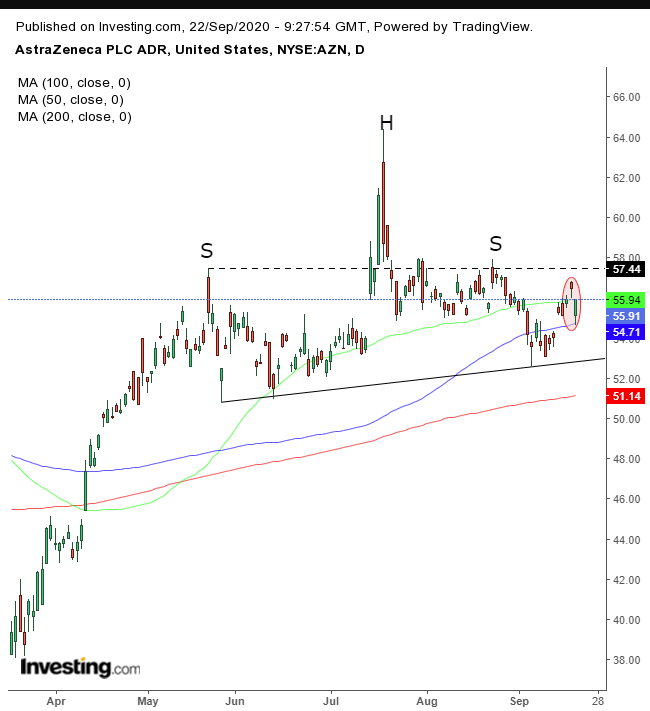The strongest and fastest equity market rally in decades, which occurred from the March 2020 lows till mid-September of this year, was fueled by two complementary fundamental themes: the Federal Reserve’s "whatever it takes, as long as it takes" support of the US's COVID-19 ravaged economy and the ongoing promise of a vaccine that would alleviate the global pandemic.
As such, shares of any big pharmaceuticals company or smaller biotech whose clinical trials showed any promise at all regarding the advancement of a coronavirus vaccine was rapidly rewarded by investors starved for both hope and an end to the heavy pressure of the pandemic as it weighed global markets.
UK-based AstraZeneca (NYSE:AZN) was considered an early leader in the race to crack the coronavirus code. But it seems to have now fallen behind.
In early September, the drugmaker, working with researches at Oxford University, voluntarily paused its clinical trial, after one of the trial participants developed a serious side effect, thought to be from the experimental vaccine. But when a second participant developed unexplained neurological symptoms, the US's Food and Drug Administration (FDA) enforced a pause while it conducts a safety review.
Though an independent review noted that the illnesses were likely not related to the vaccine, and trials in the UK, Brazil and South Africa have resumed, the FDA investigation is ongoing, thus US trials remain paused. At the same time, pharmaceutical company has been criticized for a lack of transparency.
Negative headlines are never good for a stock, so it makes sense that shares of AstraZeneca have slipped. But why did the stock plunge a full 4%, after peaking on July 20 when the company's vaccine showed promise in trials?
We can't help but pay attention to this sort of counterintuitive price action. We analyzed the supply-demand behavior that caused the divergence between the known fundamentals and the technical facts on the ground.

The price opened lower yesterday, completing an Evening Star, or Island Reversal in Western technical analysis. This pattern is named according to the expectation that the asset will fall after an apparent reversal.
The Evening Star demonstrates that after bulls gave it all they had to push the price higher, the bears came out stronger. Bulls were so optimistic they were walking on air—literally since as of last Friday there was no supply to satisfy demand.
At that point a bearish counterattack shoved bulls into a full retreat, leaving them yet further back then their original point of attack, wiping out three sessions-worth of gains as sentiment reversed. The fact that the Evening Star occurred below the height of the shoulders increases the probability that it follows H&S dynamics, as invested bears dig in their heels as they hold the line.
As of now, the price couldn’t hold onto gains above the 50 DMA. As of yesterday, it found support above the 100 DMA. Should AZN lose its grip on that moving average, the next target would be the 200 DMA and a reversal that threatens to diminish the 78% surge from the March bottom to the July top.
Trading Strategies
Conservative traders would risk a short after the price closes below the psychological $50 level and completes a return move that confirms the pattern’s integrity.
Moderate traders are likely to be content with a close below the 200 DMA and a corrective rally for a better entry, if not proof of trend.
Aggressive traders may enter a short now, provided they understand the pattern is not yet complete. They would do so on the Evening Star and the expectation of a downside breakout. The more aggressive the trade, the more critical the money management becomes. Here’s an example:
Trade Sample
- Entry: $56 – current price
- Stop-Loss: $57 – above Friday’s high
- Risk: $1
- Target: $53 – neckline support
- Reward: $3
- Risk:Reward Ratio: 1:3
Note: As the title says, this is a trade sample. It's not the actual analysis. It's not the one correct way to approach this trade. It is provided only to demonstrate the core parameters of a viable trade plan. Your budget, timing and temperament may affect the results and your experience of the trade—and indeed your overall trading. You may adjust the parameters to suit you personally.
